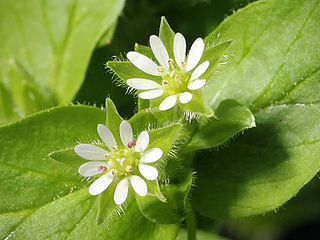
Stellaria media, chickweed, is an annual and perennial flowering plant in the family Caryophyllaceae. It is native to Eurasia and naturalized in throughout the world. This species is used as a cooling herbal remedy, and grown as a vegetable crop and ground cover for both human and poultry consumption. It is sometimes called common chickweed to distinguish it from other plants called chickweed. Other common names include chickenwort, craches, maruns, and winterweed. The plant germinates in autumn or late winter, then forms large mats of foliage.

Stellaria graminea is a species of flowering plant in the family Caryophyllaceae known by the common names common starwort, grass-leaved stitchwort, lesser stitchwort and grass-like starwort.

Alf Erling Porsild (1901–1977) was a Danish-Canadian botanist.

Arctostaphylos imbricata is a species of manzanita known by the common name San Bruno Mountain manzanita.

Campanula wilkinsiana is a rare species of bellflower known by the common name Wilkins' bellflower. It is endemic to California, where it is known fewer than twenty scattered occurrences in the Klamath Mountains and Cascade Range, and possibly the northern peaks of the High Sierra. It grows in temperate coniferous forest and mountain meadows. This is a perennial herb growing from a slender rhizome and producing an erect or leaning stem up to about 30 centimeters long. The plant is known to form dense colonies of many individuals. The thin, toothed leaves are between 1 and 2 centimeters long. The flower is bright blue to deep purple, funnel-shaped, and just over a centimeter long. The stigma is blue and protrudes from the mouth of the bloom.
Boechera dispar is a species of flowering plant in the family Brassicaceae known by the common name pinyon rockcress. It is native to eastern California and western Nevada, where it grows in rocky areas in desert and mountain habitat. This is a perennial herb growing from a branching caudex. It produces several erect stems reaching 10 to 25 centimeters tall. The leaves are mostly located about the caudex. They are linear to lance-shaped, coated in white hairs, and one or two centimeters long. The flowers have purple petals. The fruit is a long, narrow, hairless silique up to 7 centimeters long containing round, winged seeds.
Lupinus elatus is a species of lupine known by the common name tall silky lupine. It is endemic to California, where it is known from the Transverse Ranges above Los Angeles, and possibly also from the southernmost slopes of the Sierra Nevada. Its habitat includes dry areas in the forests of the mountains. This is an erect perennial herb reaching a maximum height near 90 centimeters. Each palmate leaf is made up of 6 to 8 leaflets up to 8 centimeters long. The herbage is coated in silvery silky to woolly hairs. The inflorescence is a long raceme of flowers, each about a centimeter long and arranged in whorls. The flower is purple or blue with a pale yellow patch on its banner. It yields a legume pod 2 or 3 centimeters long. This is a host plant to the Southern California native butterfly subspecies known as the San Gabriel Mountains Arrowhead Blue.

Stellaria calycantha is a species of flowering plant in the family Caryophyllaceae known by the common name northern starwort. It is native to western North America from Alaska and northwestern Canada to California and New Mexico, as well as eastern Russia. It occurs in subalpine and alpine climates, in many types of moist, shady habitat. It is a rhizomatous perennial herb producing a prostrate to erect stem up to 25 centimeters long, taking a clumpy form. The thin oval leaves have smooth edges and pointed tips, and measure up to 2.5 centimeters in length. The inflorescence bears one or more flowers, each on a long pedicel. Each flower has five pointed green sepals, and some flowers have up to five deeply lobed white petals.
Stellaria crispa is a species of flowering plant in the family Caryophyllaceae known by the common names curled starwort and crisp starwort. It is native to western North America from Alaska south to California and Wyoming, where it grows in moist, shady habitat such as deep forests and streambanks. It is a rhizomatous perennial herb producing a mat of prostrate or trailing stems up to about 40 centimeters long. It is lined with opposite pairs of pointed oval leaves each 1 to 2 centimeters long. Single flowers occur in the leaf axils, each borne on a short pedicel. The flower has five pointed green sepals each a few millimeters long. Some flowers have one or more petals, but most lack these.

Stellaria littoralis is a species of flowering plant in the family Caryophyllaceae known by the common name beach starwort. It is endemic to the San Francisco Bay Area and North Coast of California, where it grows in moist coast habitat, such as marshes, bogs, and coastal bluffs. It is a rhizomatous perennial herb producing sprawling, branching stems which are four-angled and hairy in texture, reaching up to about 60 centimeters long. The lance-shaped or pointed oval leaves are up to 4.5 centimeters long and are oppositely arranged in pairs. The inflorescence bears several flowers, each on a short pedicel. The flower has five hairy, pointed green sepals each a few millimeters long. There are five white petals, each so deeply lobed it appears to be two.

Stellaria longifolia is a species of flowering plant in the family Caryophyllaceae known by the common name longleaf starwort. It is native to much of the northern half of the Northern Hemisphere, occurring throughout northern Europe and North America. It grows in many types of moist habitat, including meadows, marshes, and roadsides. It is a rhizomatous perennial herb forming clumps with sprawling, branching stems which are mostly hairless except for tiny rough hairs along the edges of the squarish stem. The linear to lance-shaped leaves are up to 3.5 centimeters long and are oppositely arranged in pairs. The inflorescence bears several flowers, each on a short pedicel. The flower has five pointed green sepals each a few millimeters long. There are five white petals, each so deeply lobed it appears to be two.

Stellaria longipes is a species of flowering plant in the family Caryophyllaceae known by the common names longstalk starwort and Goldie's starwort. It has a circumpolar distribution, occurring throughout the northernmost latitudes of the Northern Hemisphere. It grows in a wide variety of habitat types, including tundra and taiga and many areas farther south with subalpine and alpine climates. It is extremely variable in morphology, its form depending on both genetic makeup and environmental conditions. It has a widely varying number of chromosomes. In general, it is a rhizomatous perennial herb forming mats or clumps, or growing erect. The stems may be short and simple or with sprawling and highly branched. The linear to lance-shaped leaves are usually 1 to 4 centimeters long and are oppositely arranged in pairs. The inflorescence bears one or more flowers, each on a short pedicel. The flower has five pointed green sepals each a few millimeters long. There are five white petals each divided into two lobes, sometimes shallowly, but often so deeply there appear to be two petals. The plant is gynodioecious, with some flowers having functional male and female reproductive parts and others being only female.

Stellaria nitens is a species of flowering plant in the family Caryophyllaceae known by the common names shiny chickweed and shining starwort. It is native to western North America, including British Columbia, Alberta, and the western United States, its distribution extending into Mexico at least as far as Baja California. It grows in many types of habitat, in dry and moist areas, and sometimes in disturbed places. It is an annual herb producing a slender, upright, four-angled stem from a thin taproot, reaching up to about 25 centimeters in height. Most of the leaves are located low on the stem, each measuring up to 1.5 centimeters long, with smaller, narrower leaves occurring above. The leaves are hairless except for some rough hairs along the margins, and the blades have shiny surfaces. The inflorescence bears a few flowers on short pedicels. The flower has five pointed sepals each a few millimeters long. There are sometimes five tiny white petals as well, though these are often absent.

Stellaria obtusa is a species of flowering plant in the family Caryophyllaceae known by the common names Rocky Mountain chickweed, blunt-sepaled starwort, and obtuse starwort. It is native to western North America, from British Columbia and Alberta to California to Colorado, where it grows in moist areas in forests and on mountain slopes.
Stellaria umbellata is a species of flowering plant in the family Caryophyllaceae known by the common names umbrella starwort and umbellate starwort. It is native to western North America from Alaska and northwestern Canada to the southwestern United States, as well as parts of Asia, including Siberia. It grows in subalpine and alpine climates in mountain forests and riverbanks. It is a rhizomatous perennial herb producing a slender prostrate stem up to about 20 centimeters long, sometimes forming clumps or mats. The stem is lined with pairs of oval leaves each up to about 2 centimeters long. The inflorescence is an umbel-shaped array of several flowers each on an arching or erect pedicels. The flower has five pointed green sepals each no more than 3 millimeters long. There are occasionally tiny white petals within the calyx of sepals, but these are generally absent.

Arctostaphylos gabilanensis is a rare species of manzanita known by the common name Gabilan manzanita.
Sibaropsis is a monotypic genus of flowering plants in the family Brassicaceae containing the single species Sibaropsis hammittii, which is known by the common name Hammitt's clay-cress. It is endemic to California, where it is known from two locations in the Peninsular Ranges. The plant is known from the Santa Ana Mountains of Riverside County and Viejas Mountain and nearby peaks east of San Diego. It grows in grassy habitat in openings in chaparral alongside purple needlegrass, generally in moist areas in heavy clay soils. This species and its genus were first described to science in 1997.
Erigeron lanatus is a species of flowering plant in the aster family known by the common name woolly fleabane. It is native to western North America, where it occurs in the mountains straddling the border between British Columbia and Alberta and Montana, with isolated populations occurring as far north as Yukon and as far south as Colorado.
Erigeron porsildii is an Arctic species of flowering plant in the daisy family known by the common name Porsild’s Arctic fleabane. It has been found in Alaska, Yukon, and the Northwest Territories.

Smelowskia americana is a species of Smelowskia known by the common names alpine smelowskia, Siberian smelowskia, and American false candytuft. Native to mountain ranges of western North America including the Olympic Mountains and Cascade Range of Washington and the Rocky Mountains of British Columbia and Alberta south to Colorado, it occurs on rocky outcrops and talus at subalpine and alpine elevations, i.e., from 1,300–4,000 metres (4,300–13,100 ft), and blooms from late May until early September.













